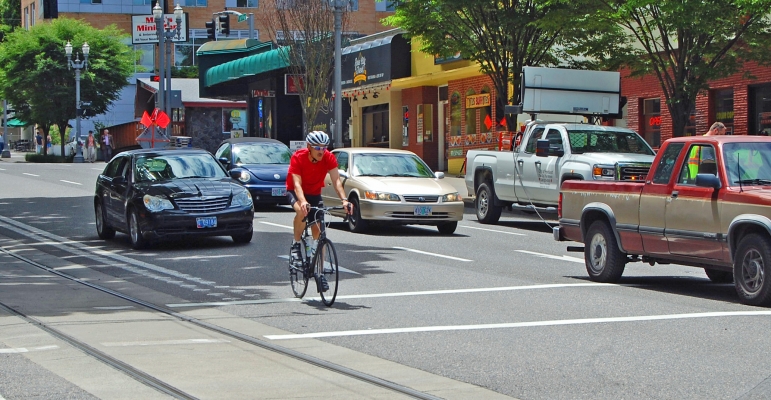Exploring the Social-Psychological Roots of Roadway Interactions

Psychology teaches us that implicit biases—attitudes we hold on a level below consciousness, and may not even be aware of—can have a heavy influence on split-second decisions.
In a fast-paced activity like driving, with a lot of moving parts in a complex environment, we make those snap decisions all the time. There are obvious safety implications to this, particularly for the most vulnerable road users. That’s why TREC researchers are becoming more and more interested in studying implicit bias and social psychology as it relates to transportation behavior.
The latest report from the NITC program, Exploring Drivers’ Attitudes and Behaviors toward Bicyclists: The Effect of Explicit and Implicit Attitudes on Self-Reported Safety Behaviors, is a dissertation by NITC fellow Tara Goddard.
With a focus on driver-cyclist interactions, Goddard dives into the social psychology of roadway interactions and comes up with some interesting takeaways for practitioners and researchers. Before moving to Portland in 2011 to begin her Ph.D., Goddard was the bicycle/pedestrian coordinator for the City of Davis, California, and says that it’s important to understand the mechanisms at play when drivers interact with cyclists.
“If we build [infrastructure] a certain way and don’t get the results we were expecting, some of that may be explained by the fact that we aren’t just rational actors; we’re all embedded in this social context,” Goddard said.
Her dissertation measures drivers’ explicit attitudes and self-reported behaviors, and then uses methods drawn from psychology to test drivers’ subconscious biases about bicyclists. Understanding drivers’ attitudes toward bicyclists, and to what degree those attitudes predict behaviors, is integral to advancing goals of community livability that incorporate safety and environmental sustainability.
Not surprisingly, one finding from the study was that drivers who sometimes biked for transportation themselves had more positive attitudes in general about cyclists on the roads. What the study revealed that was less predictable, however, was that trip purpose made a big difference. Frequent bicycling—at least once a week—also made a significant difference in drivers’ attitudes.
“Riding for recreation didn’t necessarily improve people’s attitudes, but if they commuted or ran errands by bike, that did matter. As practitioners, those findings are important because that’s an area you can work on. Weekly bicycling can make people safer drivers,” Goddard said.
Surveyed respondents almost universally agreed that they felt pressure to overtake a bicyclist traveling the same direction, so as not to hold up traffic. Research shows that people make more errors when feeling nervous or under pressure, so adding that anxiety into the mix creates additional safety concerns. Goddard sees this as a supporting argument for two things.
First? Creating separated infrastructure like protected bike lanes, so that bicycles and cars don’t travel in the same space. Second, changing the culture of the road.
"How do we change that culture so people don’t fear that other drivers will be annoyed at them for holding up traffic? I sometimes call it the 11th commandment: 'Thou shalt not hold up traffic.' It has real safety implications for vulnerable road users," Goddard said. Her research stands to improve practitioners' ability to create safer travel environments by providing a more robust understanding of the underlying psychology behind driving decisions.
For more details on this research, visit the project page or download the final report.
